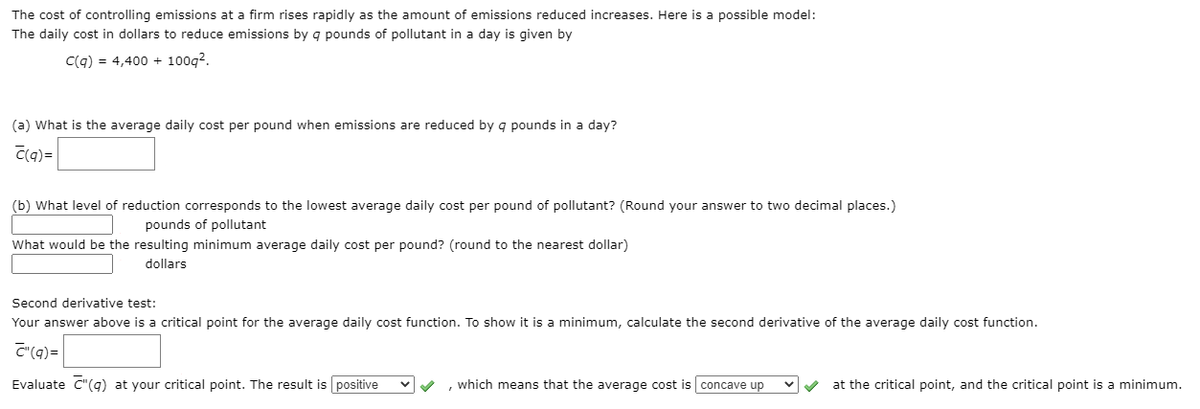The cost of controlling emissions at a firm rises rapidly as the amount of emissions reduced increases. Here is a possible model: The daily cost in dollars to reduce emissions by q pounds of pollutant in a day is given by C(q) = 4,400 + 100q?. (a) What is the average daily cost per pound when emissions are reduced by g pounds in a day? C(9) = (b) What level of reduction corresponds to the lowest average daily cost per pound of pollutant? (Round your answer to two decimal places.) pounds of pollutant What would be the resulting minimum average daily cost per pound? (round to the nearest dollar) dollars Second derivative test: Your answer above is a critical point for the average daily cost function. To show it is a minimum, calculate the second derivative of the average daily cost function. Evaluate C"(q) at your critical point. The result is positive , which means that the average cost is concave up at the critical point, and the critical point is a minimum.
The cost of controlling emissions at a firm rises rapidly as the amount of emissions reduced increases. Here is a possible model: The daily cost in dollars to reduce emissions by q pounds of pollutant in a day is given by C(q) = 4,400 + 100q?. (a) What is the average daily cost per pound when emissions are reduced by g pounds in a day? C(9) = (b) What level of reduction corresponds to the lowest average daily cost per pound of pollutant? (Round your answer to two decimal places.) pounds of pollutant What would be the resulting minimum average daily cost per pound? (round to the nearest dollar) dollars Second derivative test: Your answer above is a critical point for the average daily cost function. To show it is a minimum, calculate the second derivative of the average daily cost function. Evaluate C"(q) at your critical point. The result is positive , which means that the average cost is concave up at the critical point, and the critical point is a minimum.
College Algebra
7th Edition
ISBN:9781305115545
Author:James Stewart, Lothar Redlin, Saleem Watson
Publisher:James Stewart, Lothar Redlin, Saleem Watson
Chapter1: Equations And Graphs
Section1.3: Lines
Problem 92E
Related questions
Topic Video
Question

Transcribed Image Text:The cost of controlling emissions at a firm rises rapidly as the amount of emissions reduced increases. Here is a possible model:
The daily cost in dollars to reduce emissions by q pounds of pollutant in a day is given by
C(q) = 4,400 + 100g?.
(a) What is the average daily cost per pound when emissions are reduced by g pounds in a day?
C(q) =
(b) What level of reduction corresponds to the lowest average daily cost per pound of pollutant? (Round your answer to two decimal places.)
pounds of pollutant
What would be the resulting minimum average daily cost per pound? (round to the nearest dollar)
dollars
Second derivative test:
Your answer above is a critical point for the average daily cost function. To show it is a minimum, calculate the second derivative of the average daily cost function.
C"(q)=
Evaluate C"(q) at your critical point. The result is positive
, which means that the average cost is concave up
at the critical point, and the critical point is a minimum.
Expert Solution
This question has been solved!
Explore an expertly crafted, step-by-step solution for a thorough understanding of key concepts.
This is a popular solution!
Trending now
This is a popular solution!
Step by step
Solved in 4 steps

Knowledge Booster
Learn more about
Need a deep-dive on the concept behind this application? Look no further. Learn more about this topic, advanced-math and related others by exploring similar questions and additional content below.Recommended textbooks for you

College Algebra
Algebra
ISBN:
9781305115545
Author:
James Stewart, Lothar Redlin, Saleem Watson
Publisher:
Cengage Learning

Algebra and Trigonometry (MindTap Course List)
Algebra
ISBN:
9781305071742
Author:
James Stewart, Lothar Redlin, Saleem Watson
Publisher:
Cengage Learning

Algebra for College Students
Algebra
ISBN:
9781285195780
Author:
Jerome E. Kaufmann, Karen L. Schwitters
Publisher:
Cengage Learning

College Algebra
Algebra
ISBN:
9781305115545
Author:
James Stewart, Lothar Redlin, Saleem Watson
Publisher:
Cengage Learning

Algebra and Trigonometry (MindTap Course List)
Algebra
ISBN:
9781305071742
Author:
James Stewart, Lothar Redlin, Saleem Watson
Publisher:
Cengage Learning

Algebra for College Students
Algebra
ISBN:
9781285195780
Author:
Jerome E. Kaufmann, Karen L. Schwitters
Publisher:
Cengage Learning

Algebra & Trigonometry with Analytic Geometry
Algebra
ISBN:
9781133382119
Author:
Swokowski
Publisher:
Cengage